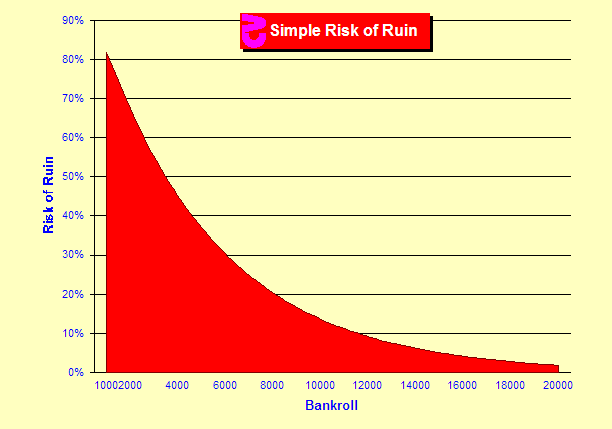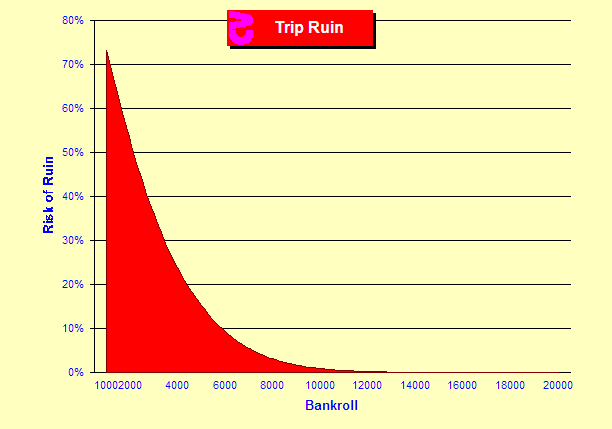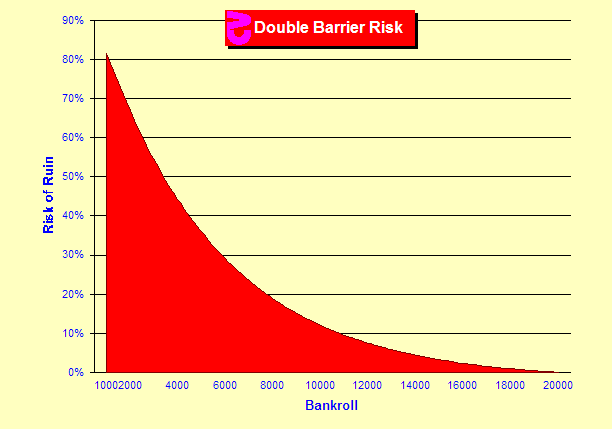|
|
Chapter 8. Bankrolls, Goals, Risk Data
| Fortunately formulae exist to aid us in planning for the inherent
volatility of Blackjack card counting. Chapter 8 charts the relationships
between bankroll, risk, goals and time, in several manners.
"Time washes clean" — Linda Ronstadt, 1970
| |
 What
is my risk of ruin? What
is my risk of ruin?
Risk of Ruin refers to the chance that you will lose your entire
bankroll. The charts on this page display three views of risk using
formulae from Don Schlesinger's Blackjack Attack. For all
charts, we are playing six decks, S17, DAS, 5/6 penetration, Hi-Lo,
betting optimally from $10-$180.
Let's start with simple risk of ruin. This is the risk of ruin
with no limit on the number of hands and no quit point. We continue
playing forever unless we go bankrupt. Along the x-axis you will
see bankrolls of $1,000 to $20,000. At the above betting level with
a $1,000 bankroll we can see an enormous risk of 82% that we will
lose our entire bankroll. We can see that larger bankrolls dramatically
reduce our risk. At a bankroll of $20,000 we see a risk of about
1.8%. At a bankroll of $18,000 (100 times the max bet of $180) the
risk is 2.75%. Obviously, changing the rules, penetration, strategy,
unit size or bet spread will significantly change this chart.
|
 What
is my Trip Risk of Ruin? What
is my Trip Risk of Ruin?
Now let us look at one trip. Trip Ruin is much the same except
there are a limited number of hands in one trip. In this chart we
are playing the same game, but we will play 5,000 hands, unless
we go bankrupt first. The curve is dramatically different here as
it is highly unlikely that we will lose an entire bankroll above
a certain size in that short a period of time. The risk is now below
1% with a $10,000 bankroll.
|
|
 What
happens when I include a goal? What
happens when I include a goal?
Let's throw in a goal. This is called a double barrier formula
because we quit playing if we win or lose specified amounts. We
are calculating the risk of bankruptcy before hitting a goal. In
this chart a goal of $20,000 is selected. We are looking at the
risk involved attempting to end up with $20,000 given bankrolls
of $1,000 to $20,000. The risk at $1,000 is nearly the same as in
the first chart, which had no goal. But the risk with a $20,000
bankroll is obviously zero and all risks in between are a bit lower.
Clearly bankroll is an important aspect of risk. But you can also
lower risk by finding better games, reducing the betting level,
or using a better strategy.
|
|
Sim details
- Six decks, S17, DAS, Heads-Up, Hi-Lo, truncate, Sweet 16 indexes,
half-deck resolution, penetrations 5/6 penetration, Spread $10-$180
- Two billion rounds each, all sims use optimal betting
|
|
|
 What
is my risk of ruin?
What
is my risk of ruin? What
is my Trip Risk of Ruin?
What
is my Trip Risk of Ruin? What
happens when I include a goal?
What
happens when I include a goal?